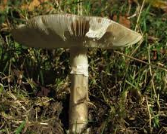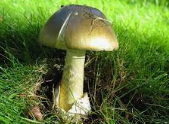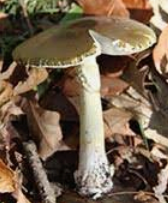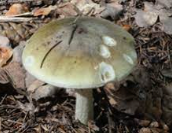The Death Cap Mushroom in Maine
Understanding the Peril: The Death Cap Mushroom in Maine
Maine’s forests are teeming with natural wonders, from towering pines to delicate wildflowers. Among these treasures lurks a silent danger: the Death Cap mushroom (Amanita phalloides). Known for its innocuous appearance and deadly consequences, this mushroom serves as a cautionary tale for mushroom enthusiasts and foragers alike.
Identification and Characteristics



The Death Cap mushroom is notoriously deceptive in its appearance. It typically features a smooth, olive-green cap, sometimes tinged with yellow or brown, and white gills underneath. Its stem is slender, often adorned with a delicate ring (annulus) and a bulbous base encased in a sac-like volva. These features can easily mislead inexperienced foragers into mistaking it for edible varieties of mushrooms.
Toxicity and Health Risks
Despite its deceptively benign appearance, the Death Cap mushroom contains potent toxins, primarily amatoxins. These toxins are heat-stable, meaning they withstand cooking temperatures, making the mushroom dangerous even when cooked. Upon ingestion, symptoms may not manifest for several hours, leading to a false sense of security. However, once symptoms appear, they progress rapidly and can include severe abdominal pain, vomiting, diarrhea, and ultimately, liver and kidney failure. Without prompt medical intervention, consumption of even a small amount can be fatal.
Habitat and Distribution
The Death Cap mushroom thrives in rich, moist soils near hardwood trees, particularly oak and beech. It is commonly found in late summer to fall, blending in with other mushrooms that populate Maine’s forests during these seasons. Its prevalence underscores the importance of caution and meticulous identification when foraging for wild mushrooms.
Safety Tips for Mushroom Foragers
For those passionate about mushroom foraging in Maine, it’s essential to prioritize safety above all else:
- Education: Take the time to learn about local mushrooms, especially poisonous species like the Death Cap. Attend workshops or join local mycological societies for guidance.
- Identification: Carefully study the distinctive features of the Death Cap and other toxic mushrooms. Use multiple sources for identification and cross-reference with experts if uncertain.
- Avoid Risky Assumptions: Never assume a mushroom is safe based on visual similarity to edible varieties. Always verify its identity through comprehensive examination.
- Discard Doubtful Specimens: If there is any doubt about a mushroom’s identity or safety, refrain from consuming it. It’s better to err on the side of caution than risk exposure to toxins.
- Medical Awareness: Familiarize yourself with the symptoms of mushroom poisoning and seek immediate medical attention if symptoms occur after ingestion, especially if you suspect exposure to the Death Cap or other toxic mushrooms.
Conclusion
The Death Cap mushroom serves as a stark reminder of the inherent risks involved in mushroom foraging. While Maine’s forests offer a bounty of edible and fascinating fungi, the presence of toxic species like the Death Cap demands vigilance and knowledge. By respecting the complexities of mushroom identification and adhering to safety guidelines, enthusiasts can safely enjoy the rewards of foraging while mitigating the risks associated with potentially lethal mushrooms.
Remember, responsible foraging is not just about enjoying nature’s harvest—it’s about ensuring a safe and enriching experience for all who venture into Maine’s breathtaking wilderness. With awareness and education, we can continue to appreciate and protect the natural wonders that make Maine’s forests so remarkable.
